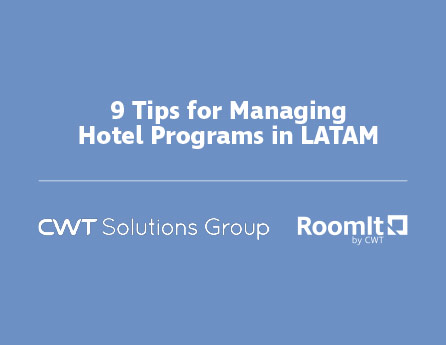
9 Things to keep in mind when working on a hotel program for the LATAM market
When managing a local portion of a large, corporate hotel program, it’s important to think about how your actions support your company’s larger travel strategy and meet local needs.
These tips will help you accomplish both.
1 Keep your eye on the LATAM market
Although APAC tends to attract more attention, the LATAM region has been turning around recently with 1.2% growth in 2018 and an expected 1.7% growth in 2019. As of 2018, there were over 800 new hotel projects being planned throughout the region.
Even if your company isn’t currently operating in this region, these positive economic signs suggest it may be time to start understanding the unique elements of managing travel in this region.
2 Add independent hotels in your high traffic areas
Like Europe, Latin America relies heavily on small and independent hotels. That means chain-wide agreements with large brands may not be an adequate way of covering your hotel needs in this region. While large hotel brands are beginning to penetrate the LATAM market in places like Mexico, there are many places, like Brazil, where chain hotels represent only about 11% of the total hospitality market.
Utilize other content sources from your travel management company like their own specially sourced rates or third-party hotel content (i.e.Booking.com or Expedia Partners Solutions) to add more property types to your hotel program.
3 Learn local fiscal regulations to save money
In-country, in-currency invoicing that follows local fiscal requirements is very important for tax and savings purposes. Taxes – VAT or IVA in Spanish (Impuestos sobre el Valor Añadido) – paid on travel can be credited against a company’s annual corporate taxes, which means invoicing for each transaction is best done locally.
Some sharing economy services and other lodging providers may not supply this receipt, which is a problem since you need a valid VAT or IVA invoice or relevant Customs receipt to support VAT claims. That can equate to a lot of lost savings when you consider that Colombia, for example, has a standard VAT of 19%. Leverage your TMC to help remind travelers about requesting a VAT compliant invoice, and to provide you, or a supplier, with all the relevant VAT recovery data.
4 Prepayment is popular
Travelers in LATAM and other emerging markets often do not carry credit cards. Prepayment makes travel easy for LATAM travelers, as they can rest assured that all costs are covered ahead of time.
It’s important to utilize payment services that are globally focused and support various payment types. That way companies can provide the same payment experience for their travelers regardless of their regional-specific needs.
5 Expect wide use of travel approvers
Companies operating within LATAM often still take a more hands-on approach managing travel spend. The industry, in general, is moving away from individual approvers due to its inefficiency, so there may be need for a culture change here. That means a lot more education and communication with travelers and managers in this region about how corporate policy and established booking channels can accomplish the same thing in a more efficient way.
6 Mobile is heavily relied on
Latin America is the second fastest growing mobile market, and many countries, such as Brazil, have sizable populations of mobile users who do not own a personal laptop or desktop computer. They are used to relying on phones for internet-based activities. Plus, safety alerts and medical advisories can be automatically distributed via SMS, helping you mitigate against travel risks.
Therefore ensuring your travelers have mobile access and a preferred booking app with a great user experience is pivotal for maintaining high compliance in this region.
7 They like their breakfast hot
Breakfast and hot breakfast are not the same thing in LATAM. Most travelers in this region only consider it breakfast if it’s hot. Many hotels in the region now realize this, but it’s important to remember if you’re negotiating for breakfast inclusion, continental breakfasts will not suffice.
8 It’s hard to stay connected
Premium Wi-Fi inclusion continues to be among the most important amenities for business travelers, yet even basic Wi-Fi isn’t always available at hotels in Latin American countries. This may be why business travelers in Mexico identified Wi-Fi inclusion as the most important determinant when choosing a hotel; more important than distance to worksite, price, breakfast inclusion and even photos of the hotel.
Many travelers won’t have data or roaming services that work when traveling into or between Latin American countries either, so making sure travelers have Wi-Fi access at their hotels is extremely important for this region.
9 Price tracking is for more than just air
A common misconception in this region is that price tracking tools are only for air bookings. Make sure divisions operating within this region know about price tracking tools for hotels and have it turned on. They should know that price tracking tools automatically book similar rates at the same hotels while producing a 1-2% total program savings.
Learn more about managing travel in LATAM
Sources:
GBTA/RoomIt, “Improving Hotel Programs in 2019” study
Best Western and RoomIt Research Findings, 2019

